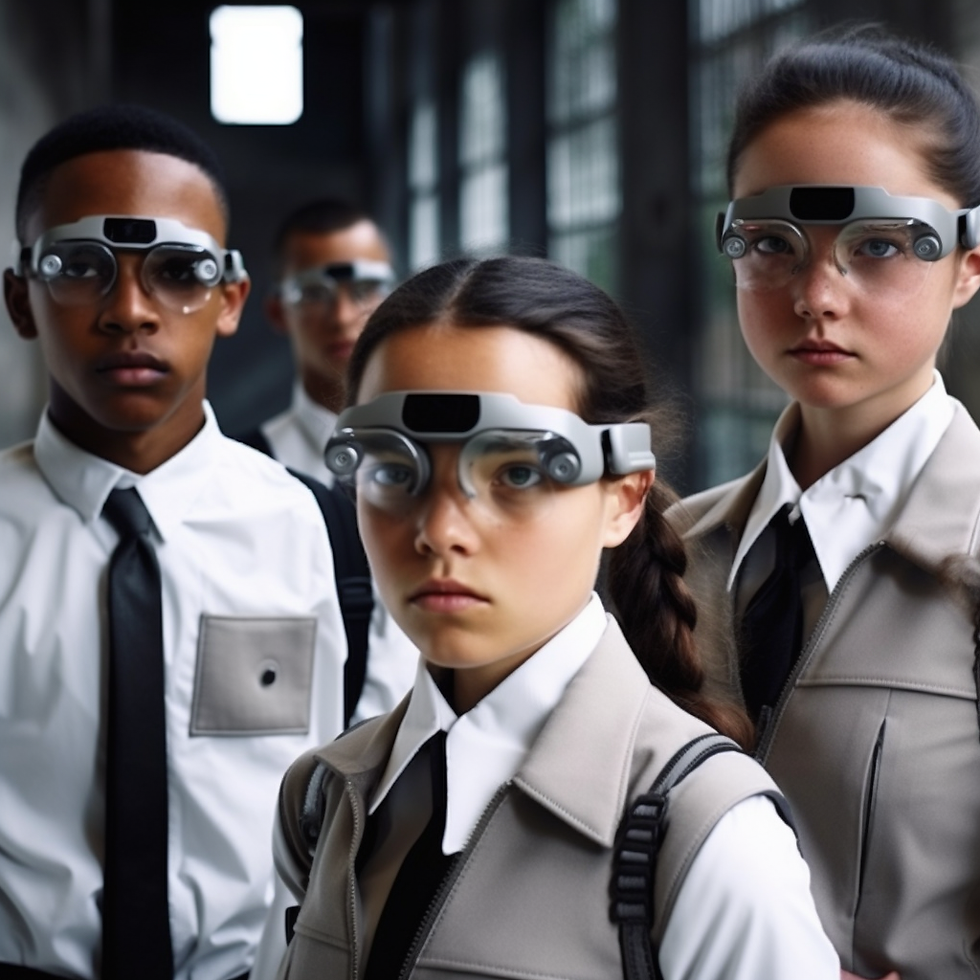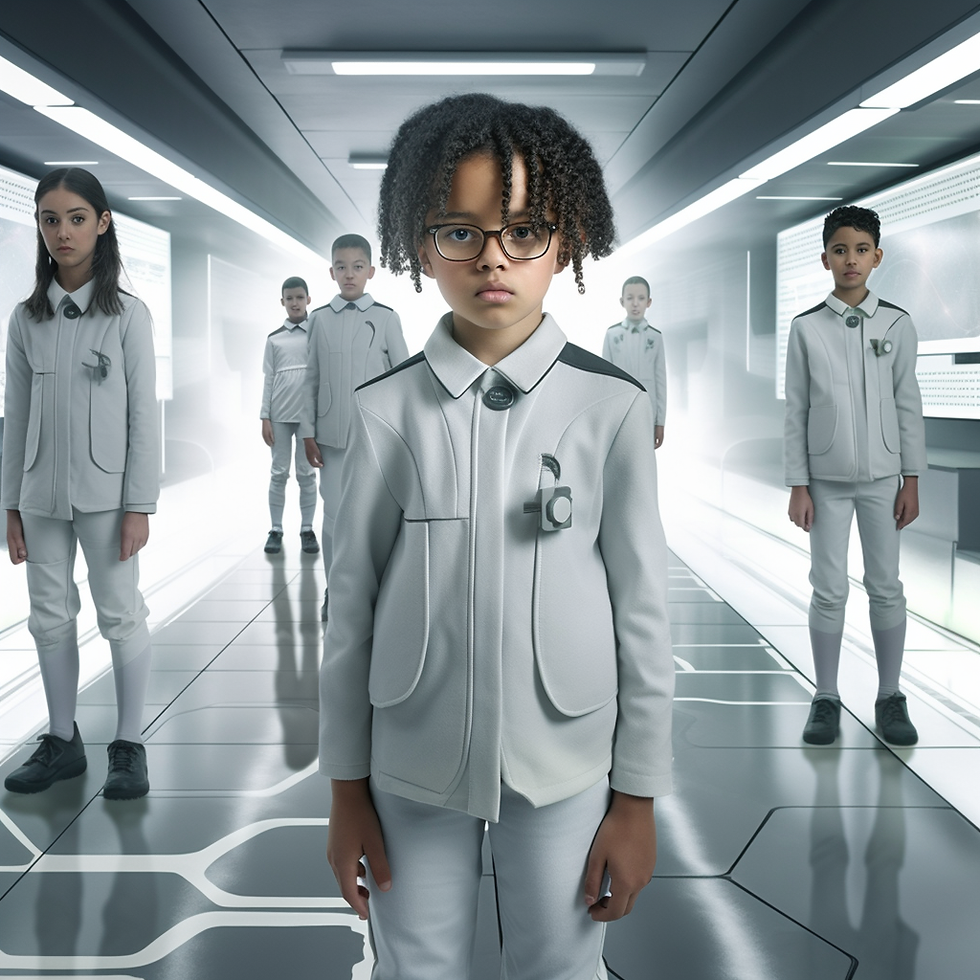High-Tech School Uniforms: 2050 Preview
- K-12 Clothing

- Mar 21, 2023
- 6 min read
Updated: Jun 2, 2023
What Is High-Tech Uniform?
The year 2050 might seem far-fetched, but with technological advancements, it's not impossible to imagine high-tech school uniforms becoming a reality. These uniforms will have advanced features such as embedded sensors that monitor students' physical activities and biometrics. The data collected from these sensors will be used to improve students' health and academic performance.

Besides the health benefits, high-tech school uniforms will also have enhanced security features. For instance, the uniforms could have GPS tracking systems that ensure that students are where they're supposed to be at all times. This feature would make monitoring their children easier for teachers and parents.
Finally, High-tech school uniforms could also include augmented reality (AR) technology that allows students to access educational content in an immersive way. AR technology can bring textbooks and other materials to life by adding interactive elements such as videos, animations, or simulations. With this technology, learning can become more engaging and exciting for students.
Connected Devices: Wearable Tech
In the year 2050, high-tech school uniforms are not just a far-fetched idea but a reality. These uniforms feature wearable tech, making learning more engaging and interactive for students. For instance, students can use their smartwatches to access online resources and submit homework assignments with ease.
The high-tech school uniforms also have sensors that enable teachers to monitor individual student progress in real-time. The data collected helps them identify areas where learners need assistance and adjust their teaching accordingly. Additionally, the wearables promote physical fitness by tracking steps taken during recess or other physical activities.
Overall, the future of education is exciting, with connected devices such as wearable tech paving the way for new opportunities in learning.
Textiles of the Future: Smart Fabrics
The textiles of the future will be not only aesthetically pleasing but also functional. Smart fabrics infused with technology and embedded with sensors will become the norm, transforming our daily lives. Imagine school uniforms that can monitor a student's health and hydration levels or even alert teachers to potential issues such as bullying.
These smart fabrics will have not only practical applications but also artistic ones. Light-reflecting fabrics that change color in response to different light sources or emotions may become popular fashion statements. Smart clothing could even incorporate artificial intelligence for personalized recommendations based on one's preferences and body type.
The possibilities are endless for the future of textiles, and we can look forward to a time when our clothes are more than just something to wear--they'll be an extension of ourselves.

Safety and Security Features
One of the most notable changes that will come with high-tech school uniforms is the addition of advanced safety and security features. In 2050, students will no longer need to carry a separate ID card or swipe their ID at a scanner because they will have biometric identification built into their uniforms. Schools can quickly identify who enters and exits the building, reducing the risk of unauthorized individuals gaining access.
Another important safety feature in high-tech school uniforms is GPS tracking technology. Parents and teachers can track students' whereabouts through an app on their phones, ensuring that children are always safe and accounted for. Additionally, uniforms may include sensors that detect motion or impacts, alerting school officials in real time if a student falls or gets injured.
Overall, these advanced features in high-tech school uniforms provide peace of mind for parents, teachers, and students alike. With increased safety measures built into the clothing, schools can focus more on education while keeping students secure.
Education Potential: Interactive Learning
With the rapid advancement of technology, it's no surprise that high-tech school uniforms are predicted to become a reality in the year 2050. These uniforms will revolutionize education by incorporating interactive learning experiences into daily classroom activities.
One potential feature of high-tech school uniforms is augmented reality (AR) technology. Using a smartphone or tablet app, students can bring textbook images and lessons to life through 3D animations and simulations. This interactive learning type will significantly enhance student engagement and retention rates.
Another exciting prospect for high-tech school uniforms includes biometric sensors that monitor everything from heart rate to posture. The data collected from these sensors could be used by teachers to understand their students' needs better and adjust lesson plans accordingly. Additionally, this information could help schools identify areas where students need extra support, enabling them to provide tailored educational experiences for each student.

Personalization Options: Design and Color
In 2050, high-tech school uniforms will offer various personalization options, including design and color. Technological advances allow students to access interactive uniform materials that change colors or patterns based on their surroundings or mood. This could be especially useful for students who want to blend in with their environment or express themselves creatively through clothing.
Design options could include customizable patches or badges representing a student's interests or achievements. These badges could also have embedded sensors that track physical activity and health data. Additionally, schools may use augmented reality technology to let students personalize their uniforms digitally, creating unique designs that can be projected onto their clothing.
Overall, personalized school uniforms could enhance student engagement and identity by allowing them greater control over their appearance and providing opportunities for self-expression. As technology continues to evolve, it will be interesting to see how these advancements impact the future of school uniforms.

Conclusion
In conclusion, the future of school uniforms appears to be trending toward high-tech solutions. With new technologies like integrated sensors and smart fabrics, students could soon access a wide range of features and functions built into their uniforms. These could include everything from biometric tracking for attendance purposes to personalized temperature control systems that adapt based on each student's needs.
While these innovations certainly have potential benefits, it is also vital for schools and educators to consider the potential drawbacks. For example, some critics argue that high-tech school uniforms could further erode privacy rights for students living in an increasingly monitored world. Additionally, there may be concerns around cost and accessibility - with some parents and communities unable or unwilling to pay for these advanced uniform options.
Ultimately, whether or not to adopt high-tech school uniforms will depend on various factors unique to each school district or educational institution. However, one thing is clear: technology is rapidly changing every aspect of our lives - and school uniforms are no exception. As we look toward the future of education, it will be interesting to see how these advancements continue to shape how we think about learning environments and student experiences.
Cost of School Uniforms vs. Regular Clothes Statistics and Other Frequently Asked Questions
The cost of school uniforms compared to regular clothes varies significantly depending on various factors, such as quality, brand, and place of purchase. Here are some estimated costs based on information up until my last update in September 2021:
School Uniforms: School uniform pieces can cost around $20 - $50 each for a medium-quality brand. A complete uniform, including shirts, pants or skirts, and a jumper or sweater, could cost approximately $100 - $250 per child annually. This estimate assumes a few sets of uniforms are purchased to last throughout the school year.
Regular Clothes: The cost of regular clothes for children is highly variable, depending on brand, style, and shopping frequency. On average, parents might spend anywhere from $200 - $400 per child each year on regular clothing.
Please note these are just rough estimates. Actual costs could be lower or higher based on specific circumstances.
Here are some additional FAQs around this topic:
Q: How often do school uniforms need to be replaced? A: The replacement frequency of school uniforms depends on the uniform's quality and the student's growth rate. Usually, uniforms might need to be replaced every one to two years. However, for younger children who are growing quickly, replacements might need to be more frequent.
Q: Are there any cost-saving strategies for purchasing school uniforms? A: Yes, some strategies for cost-effective uniform purchases include buying second-hand, shopping during sales, buying from discount retailers, or participating in school-organized uniform exchange programs.
Q: How can the cost of regular clothes be minimized? A: The cost of regular clothes can be minimized by buying during sales, shopping at a discount or second-hand stores, and purchasing versatile pieces that can be combined to create different outfits.
Q: What effects can wearing school uniforms have on students? A: Studies suggest that wearing school uniforms can have several effects. They can reduce peer pressure and bullying related to clothing, foster a sense of community among students, and minimize distractions, thus enhancing focus on academics. However, some argue that uniforms may limit personal expression and individuality.
Q: Why do some schools mandate uniforms? A: Schools may mandate uniforms for reasons such as promoting equality among students, avoiding distractions, minimizing violence or bullying related to clothing, or encouraging a more serious academic atmosphere.


.png)

